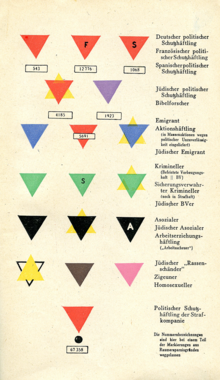
Nazi concentration camp badges, primarily triangles, were part of the system of identification in German camps. They were used in the concentration camps in the German-occupied countries to identify the reason the prisoners had been placed there. The triangles were made of fabric and were sewn on jackets and trousers of the prisoners. These mandatory badges of shame had specific meanings indicated by their colour and shape. Such emblems helped guards assign tasks to the detainees. For example, a guard at a glance could see if someone was a convicted criminal (green patch) and thus likely of a tough temperament suitable for kapo duty.
Someone with an escape suspect mark usually would not be assigned to work squads operating outside the camp fence. Someone wearing an F could be called upon to help translate guards' spoken instructions to a trainload of new arrivals from France. Some historical monuments quote the badge-imagery, with the use of a triangle being a sort of visual shorthand to symbolize all camp victims.
The modern-day use of a pink triangle emblem to symbolize gay rights is a response to the camp identification patches.
Badge coding system
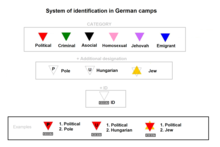
The system of badges varied between the camps and in the later stages of World War II the use of badges dwindled in some camps and became increasingly accidental in others. The following description is based on the badge coding system used before and during the early stages of the war in the Dachau concentration camp, which had one of the more elaborate coding systems.
Shape was chosen by analogy with the common triangular road hazard signs in Germany that denote warnings to motorists. Here, a triangle is called inverted because its base is up while one of its angles points down.
Single triangles
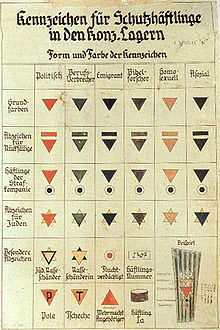
This section has multiple issues. Please help improve it or discuss these issues on the talk page. (Learn how and when to remove these messages)
Main problem: all demographics listed for each color need a source. This section has multiple sources, but most key points don't have a clear attribution. Please put sources at the end of each dot point or sentence, if a sentence or dot point has multiple sources add a list or quote to each reference to clearly indicate which points it supports. When most of the key points have a source, remove this notice and use or to mark any that remain unsourced. (Learn how and when to remove this message) |
- Red triangle – political prisoners: occupied country resistance members (partisans), social democrats, liberals, socialists, communists, anarchists, gentiles who assisted Jews; trade unionists, and Freemasons.
- Green triangle – convicts and criminals (often working as kapos).
- Blue triangle – foreign forced laborers and emigrants. This category included statelessness people ("apatrides"), Spanish refugees from Francoist Spain whose citizenship was revoked and emigrants to countries which were occupied by Nazi Germany or were under German sphere of influence.
- Purple triangle – primarily Jehovah's Witnesses (over 99%) as well as members of other small pacifist religious groups.
- Pink triangle – primarily homosexual men and those who were identified as such at the time (e.g., bisexual men, male prostitutes, and those deemed 'transvestites') and sexual offenders as well as pedophiles and zoophiles. Many in this group were subject to forced sterilization.
- Black triangle – people who were deemed asocial elements (asozial) and work-shy (arbeitsscheu), including the following:
- Roma and Sinti. They wore the black triangle with a Z notation (for Zigeuner, meaning Gypsy) to the right of the triangle's point. Roma were later assigned a brown triangle.
- Mentally ill and developmentally disabled. Their triangles were additionally inscribed with the word Blöd, meaning stupid. This category included, notably, autistic people among this group. Though many others including schizophrenic and epileptic people were forcibly sterilized, shot, or gassed in psychiatric institutions as opposed to at the Nazi camps.
- Alcoholics and drug addicts.
- Vagrants and beggars.
- Pacifists and conscription resisters.
- Sex workers.
- Lesbians.
- Other disabled people, such as people with diabetes (as "Diabetes was conceptualized as a Jewish disease not necessarily because its prevalence was high among this population, but because medicine, science, and culture reinforced each other").
- Brown triangle – Assigned to Roma later on in the Romani Holocaust.
- Uninverted red triangle – an enemy POW (Sonderhäftling, meaning special detainee), a spy or traitor (Aktionshäftling, meaning activities detainee), or a military deserter or criminal (Wehrmachtsangehöriger, meaning Armed Forces member).
- Some period examples of the single triangle design at Nazi camps
-
 Single-triangle badges in various colors visible on Sachsenhausen concentration camp detainees
Single-triangle badges in various colors visible on Sachsenhausen concentration camp detainees
-
 Single-triangles visible on Sachsenhausen detainees
Single-triangles visible on Sachsenhausen detainees
-
Specimen indicating a Jehovah's Witness
-
 Red emblems of a political enemy on a Dachau detainee's clothing.
Red emblems of a political enemy on a Dachau detainee's clothing.
-
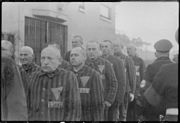 More Sachsenhausen detainees
More Sachsenhausen detainees
-
 Black triangles visible on the trousers of Romani detainees at Dachau
Black triangles visible on the trousers of Romani detainees at Dachau
-
 United States Army photo of Austrian economist and financial specialist Benedikt Kautsky [de], a political prisoner, who was liberated from Buchenwald
United States Army photo of Austrian economist and financial specialist Benedikt Kautsky [de], a political prisoner, who was liberated from Buchenwald
-
 Liberated Neuengamme survivor standing on the right has a triangle patch with a top-bar
Liberated Neuengamme survivor standing on the right has a triangle patch with a top-bar
-
German concentration camp badge for Polish (non-Jewish) political prisoner in Stutthof.ID 29659 – Lidia Główczewska [pl]
Double triangles
See also: Yellow badgeThis section has multiple issues. Please help improve it or discuss these issues on the talk page. (Learn how and when to remove these messages)
The current source(s) support(s) only a small part of the text. When most of the points information has a source, please remove this notice and use to mark any information that remains unsourced. (Learn how and when to remove this message) |
Double-triangle badges resembled two superimposed triangles forming a Star of David, a Jewish symbol.
- Red inverted triangle superimposed upon a yellow one representing a Jewish political prisoner.
- Blue inverted triangle superimposed upon a red one representing foreign forced labour and political prisoner (for example, Spanish Republicans in Mauthausen).
- Green inverted triangle superimposed upon a yellow one representing a Jewish habitual criminal.
- Purple inverted triangle superimposed upon a yellow one representing a Jehovah's Witness of Jewish descent.
- Pink inverted triangle superimposed upon a yellow one representing a Jewish "sexual offender", typically a gay or bisexual man.
- Black inverted triangle superimposed upon a yellow one representing an "asocial" or work-shy Jew.
- Voided black inverted triangle superimposed over a yellow triangle representing a Jew convicted of miscegenation and labelled as a Rassenschänder (race defiler).
- Yellow inverted triangle superimposed over a black triangle representing an "Aryan" woman convicted of miscegenation and labelled as a Rassenschänder (race defiler).
Like those who wore pink and green triangles, people in the bottom two categories would have been convicted in criminal courts.
- Some period examples of the double triangle design at Nazi camps
-
 Sachsenhausen detainee with glasses in the foreground wears a two-color ID-emblem
Sachsenhausen detainee with glasses in the foreground wears a two-color ID-emblem
-
 Disabled Jews with a black triangle on a yellow triangle, meaning asocial Jews, Buchenwald, 1938.
Disabled Jews with a black triangle on a yellow triangle, meaning asocial Jews, Buchenwald, 1938.
-
 Part of a Dachau roll call – day badges visible on detainees
Part of a Dachau roll call – day badges visible on detainees
-
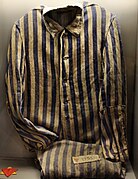 Sachsenhausen detainee's red political enemy triangle atop a yellow Jew triangle (lower left)
Sachsenhausen detainee's red political enemy triangle atop a yellow Jew triangle (lower left)
Distinguishing marks
| This section does not cite any sources. Please help improve this section by adding citations to reliable sources. Unsourced material may be challenged and removed. (November 2024) (Learn how and when to remove this message) |
In addition to color-coding, non-German prisoners were marked by the first letter of the German name for their home country or ethnic group. Red triangle with a letter, for example:
- B (Belgier, Belgians)
- E (Engländer, "English"; in practice used for all British)
- F (Franzosen, French)
- I (Italiener, Italians)
- J (Jugoslawen, Yugoslavs)
- N (Niederländer, Dutch)
- No (Norweger, Norwegian)
- P (Polen, Poles)
- S (republikanische Spanier, Republican Spanish)
- T (Tscheche, Czechs)
- U (Ungarn, Hungarians)
- Z notation next to a black triangle (Zigeuner, Gypsy).
Polish emigrant laborers originally wore a purple diamond with a yellow backing. A letter P (for Polen) was cut out of the purple cloth to show the yellow backing beneath.
Furthermore, repeat offenders (rückfällige, meaning recidivists) would receive bars over their stars or triangles, a different colour for a different crime.
- A political prisoner would have a red bar over their star or triangle.
- A professional criminal would have a green bar.
- A foreign forced laborer would not have a blue bar (as their impressment was for the duration of the war), but might have a different coloured bar if they were drawn from another pool of inmates.
- A Jehovah's Witness would have a purple bar.
- A homosexual or sex offender would have a pink bar.
- An asocial would have a black bar.
- Roma and Sinti would usually be incarcerated in special sub-camps until they died and so would not normally receive a repeat stripe.
Later in the war (late 1944), to save cloth Jewish prisoners wore a yellow bar over a regular point-down triangle to indicate their status. For instance, regular Jews would wear a yellow bar over a red triangle while Jewish criminals would wear a yellow bar over a green triangle.
Special marks
| This section needs additional citations for verification. Please help improve this article by adding citations to reliable sources in this section. Unsourced material may be challenged and removed. Find sources: "Nazi concentration camp badge" – news · newspapers · books · scholar · JSTOR (October 2019) (Learn how and when to remove this message) |
Many various markings and combinations existed. A prisoner would usually have at least two and possibly more than six.
Limited preventative custody detainee (Befristete Vorbeugungshaft Häftling, or BV) was the term for general criminals (who wore green triangles with no special marks). They originally were only supposed to be incarcerated at the camp until their term expired and then they would be released. However, when the war began they were confined indefinitely for its duration.
Erziehungshäftlinge (reformatory inmates) wore E or EH in large black letters on a white square. They were made up of intellectuals and respected community members who could organize and lead a resistance movement, suspicious persons picked up in sweeps or stopped at checkpoints, people caught performing conspiratorial activities or acts and inmates who broke work discipline. They were assigned to hard labor for six to eight weeks and were then released. It was hoped that the threat of permanent incarceration at hard labor would deter them from further action.
Polizeihäftlinge (police inmates), short for Polizeilich Sicherungsverwahrte Häftlinge (police secure custody inmates), wore either PH in large black letters on a white square or the letter S (for Sicherungsverwahrt – secure custody) on a green triangle. To save expense, some camps had them just wear their civilian clothes without markings. Records used the letter PSV (Polizeilich Sicherungsverwahrt) to designate them. They were people awaiting trial by a police court-martial or who were already convicted. They were detained in a special jail barracks until they were executed.
Some camps assigned Nacht und Nebel (night and fog) prisoners had them wear two large letters NN in yellow.
Soviet prisoners of war (russische Kriegsgefangenen) assigned to work camps (Arbeitslager) wore two large letters SU (for sowjetischer Untermensch, meaning Soviet sub-human) in yellow and had vertical stripes painted on their uniforms. They were the few who had not been shot out of hand or died of neglect from untreated wounds, exposure to the elements, or starvation before they could reach a camp. They performed hard labor. Some joined Andrey Vlasov's Liberation Army to fight for the Germans.
Labor education detainees (Arbeitserziehung Häftling) wore a white letter A on their black triangle. This stood for Arbeitsscheuer ("work-shy person"), designating stereotypically "lazy" social undesirables like Gypsies, petty criminals (e.g. prostitutes and pickpockets), alcoholics/drug addicts and vagrants. They were usually assigned to work at labor camps.
Asoziale (anti-socials) inmates wore a plain black triangle. They were considered either too "selfish" or "deviant" to contribute to society or were considered too impaired to support themselves. They were therefore considered a burden. This category included pacifists and conscription resisters, petty or habitual criminals, the mentally ill and the mentally and/or physically disabled. They were usually executed.
The Wehrmacht Strafbattalion (punishment battalion) and SS Bewährungstruppe (probation company) were military punishment units. They consisted of Wehrmacht and SS military criminals, SS personnel convicted by an Honor Court of bad conduct and civilian criminals for which military service was either the assigned punishment or a voluntary replacement of imprisonment. They wore regular uniforms, but were forbidden rank or unit insignia until they had proven themselves in combat. They wore an uninverted (point-upwards) red triangle on their upper sleeves to indicate their status. Most were used for hard labor, "special tasks" (unwanted dangerous jobs like defusing landmines or running phone cables) or were used as forlorn hopes or cannon fodder. The infamous Dirlewanger Brigade was an example of a regular unit created from such personnel.
A Strafkompanie (punishment company) was a hard labor unit in the camps. Inmates assigned to it wore a black roundel bordered white under their triangle patch.
Prisoners "suspected of escape" (Fluchtverdächtiger) wore a red roundel bordered white under their triangle patch. If also assigned to hard labor, they wore the red roundel under their black Strafkompanie roundel.
A prisoner-functionary (Funktionshäftling), or kapo (boss), wore a cloth brassard (their Kennzeichen, or identifying mark) to indicate their status. They served as camp guards (Lagerpolizei), barracks clerks (Blockschreiber) and the senior prisoners (ältesten, meaning elders) at the camp (lagerältester), barracks (blockältester) and room (stubenältester) levels of camp organization. They received privileges like bigger and sometimes better food rations, better quarters (or even a private room), luxuries (like tobacco or alcohol) and access to the camp's facilities (like the showers or the pool). Failure to please their captors meant demotion and loss of privileges and an almost certain death at the hands of their fellow inmates.
Detainees wearing civilian clothing (more common later in the war) instead of the striped uniforms were often marked with a prominent X on the back. This made for an ersatz prisoner uniform. For permanence, such Xs were made with white oil paint, with sewn-on cloth strips, or were cut (with underlying jacket-liner fabric providing the contrasting color). Detainees would be compelled to sew their number and (if applicable) a triangle emblem onto the fronts of such X-ed clothing.
- Some period examples of nationality-letter marking at Nazi camps
-
 F on red triangle (French political enemy) on Buchenwald clothing of Dr. Joseph Brau
F on red triangle (French political enemy) on Buchenwald clothing of Dr. Joseph Brau
-
F-triangle on Buchenwald clothing of Dr. Joseph Brau
-
 Specimen meaning Polish political enemy
Specimen meaning Polish political enemy
-
Stutthof detainee 29659 – Lidia Główczewska, which showcases the letter P on a red triangle for Polish political enemy
-
 Auschwitz detainee Ignacy Kwarta wears a red P-triangle, meaning a Polish political enemy.
Auschwitz detainee Ignacy Kwarta wears a red P-triangle, meaning a Polish political enemy.
-
 Dutch Jews wearing a yellow star and the letter N for Niederländer at Mauthausen
Dutch Jews wearing a yellow star and the letter N for Niederländer at Mauthausen
-
Sachsenhausen-issued red F emblem for a French political enemy
-
 Emblems were also used on some detainee ID-cards as shown here on the Mauthausen card of Polish scientist Jerzy Kaźmirkiewicz, where a P-triangle appears.
Emblems were also used on some detainee ID-cards as shown here on the Mauthausen card of Polish scientist Jerzy Kaźmirkiewicz, where a P-triangle appears.
-
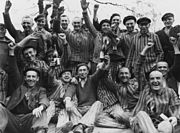 Dachau survivors toast their liberation as the man standing in center between the bottles wears a P triangle.
Dachau survivors toast their liberation as the man standing in center between the bottles wears a P triangle.
-
 Liberated Bergen-Belsen survivor with a late war ersatz variant (left) showcasing no cloth patch, but a prominent N marked on the outer clothes
Liberated Bergen-Belsen survivor with a late war ersatz variant (left) showcasing no cloth patch, but a prominent N marked on the outer clothes
-
 Plate with concentration camp marking.
Plate with concentration camp marking.
- The concept of an official transgender identity did not exist at this time. A majority of these people would likely identify as transgender if they lived in the modern era. See Transvestite pass for more information on how they were classified.
Table of camp inmate markings
| Politisch (political prisoner) | Berufsverbrecher (professional criminal) | Emigrant (foreign forced laborer) | Bibelforscher (Jehovah's Witnesses, lit. transl. bible student) | Homosexuell (male homosexual/sex offender) | Arbeitsscheu (work-shy)/Asozial (asocial) | Zigeuner (Gypsy (Roma or Sinti male)) | |
|---|---|---|---|---|---|---|---|
| Basic colours | |||||||
| Markings for repeaters | 
|

|

|

|

|

|

|
| Inmates of Strafkompanie (punishment companies) | 
|

|

|

|

|

|

|
| Markings for Jews | 
|

|

|

|

|

|

|
| Political prisoner nationality markings The capital letter of the name of the country on a red triangle |
Belgier (Belgian) | Tscheche (Czech) | Franzose (French) | Pole (Polish) | Spanier (Spanish) | ||

|
|||||||
| Special markings | Jüdischer Rassenschänder Jewish race defiler |
Rassenschänderin Female race defiler |
Escape suspect | Häftlingsnummer Inmate number |
Kennzeichen für Funktionshäftlinge Special inmates' brown armband |
Enemy POW or deserter | |

|

|

|

|
||||
| Example | 
|
Marks were worn in descending order as follows: inmate number, repeater bar, triangle or star, member of penal battalion, escape suspect. In this example, the inmate is a Jewish convict with multiple convictions, serving in a Strafkompanie (penal unit) and who is suspected of trying to escape. | |||||
Postwar use
Triangle-motifs appear on many postwar memorials to the victims of the Nazis. Most triangles are plain while some others bear nationality-letters. The otherwise potentially puzzling designs are a direct reference to the identification patches used in the camps. On such monuments, typically an inverted (point down, base up) triangle (especially if red) evokes all victims, including also the non-Jewish victims like Poles and other Slavs, communists, homosexuals, Roma and Sinti (see Porajmos), people with disability (see Action T4), Soviet POWs and Jehovah's Witnesses. An inverted triangle colored pink would symbolize gay male victims. A non-inverted (base down, point up) triangle and/or a yellow triangle is generally more evocative of the Jewish victims.
- Some examples of camp triangle emblems on monuments and related uses
-
At Sachsenhausen
-
A Dora Todesmarsch (death march) roadside tablet marked only with the date and a red triangle
-
 On the Klooga Jewish victims' memorial
On the Klooga Jewish victims' memorial
-
On a Buchenwald Todesmarsch (death march) route historical marker
-
 On a Sachsenhausen death march route historical marker
On a Sachsenhausen death march route historical marker
-
 Monument (in the village of Grabow-Below) for Ravensbrück death march victims
Monument (in the village of Grabow-Below) for Ravensbrück death march victims
-
 On a Wöbbelin memorial stone
On a Wöbbelin memorial stone
-
 Boulder (in Lindenring) for 2,000 women victims of Ravensbrück
Boulder (in Lindenring) for 2,000 women victims of Ravensbrück
-
On a Cap Arcona incident memorial
-
 At the Neustadt-Glewe concentration camp memorial
At the Neustadt-Glewe concentration camp memorial
-
F-triangle at Mauthausen-Gusen honors French victims
-
 B-triangle incorporated into the Belgian Political Prisoner's Cross
B-triangle incorporated into the Belgian Political Prisoner's Cross
-
 F-triangle at Hinzert honors French victims, especially of the Nacht und Nebel program
F-triangle at Hinzert honors French victims, especially of the Nacht und Nebel program
-
On a monument to Neuengamme victims in Hamburg, where the letters KZ are not nationality-letters, but rather are the German abbreviation for Konzentrationslager
(concentration camp) -
On a memorial to victims killed at Genshagen (right panel), where the letters KZ are not nationality-letters but rather are the German abbreviation for Konzentrationslager
(concentration camp) -
P-triangle at a Zgorzelec memorial
-
 P-triangle on the Polish medal for camp victims
P-triangle on the Polish medal for camp victims
-
 Various badges on a Dachau memorial
Various badges on a Dachau memorial
-
Pink triangle (Rosa Winkel in German) memorial for gay men killed at Buchenwald
-
 In the Berlin Nollendorfplatz subway station, a pink triangle plaque honors gay male victims.
In the Berlin Nollendorfplatz subway station, a pink triangle plaque honors gay male victims.
-
 Amsterdam's Homomonument uses pink triangles symbolically to memorialize gay men killed in the Holocaust and also victims of anti-gay violence generally.
Amsterdam's Homomonument uses pink triangles symbolically to memorialize gay men killed in the Holocaust and also victims of anti-gay violence generally.
-
 Memorial to French victims of Dachau Concentration Camp at Père Lachaise Cemetery in Paris.
Memorial to French victims of Dachau Concentration Camp at Père Lachaise Cemetery in Paris.
-
 Triangle emblem on the memorial to Nazi-era forced labor deaths at the truck factory in Zittau
Triangle emblem on the memorial to Nazi-era forced labor deaths at the truck factory in Zittau
-
 Every year, a pink triangle is erected on Twin Peaks in San Francisco during Pride weekend.
Every year, a pink triangle is erected on Twin Peaks in San Francisco during Pride weekend.
2020 Trump campaign
In June 2020, the re-election campaign of Donald Trump posted an advertisement on Facebook stating that "Dangerous MOBS of far-left groups are running through our streets and causing absolute mayhem" and identifying them as "ANTIFA", accompanied by a graphic of a downward-pointing red triangle. The ads appeared on the Facebook pages of Donald Trump, the Trump campaign, and Vice President Mike Pence. Many observers compared the graphic to the symbol used by the Nazis for identifying political prisoners such as communists, social democrats and socialists. Many noted the number of ads – 88 – which is associated with neo-Nazis and white supremacists.
As an example of the public outcry against the use of the downward-pointing red triangle, as reported by MotherJones, the Twitter account (@jewishaction), the account of Bend the Arc: Jewish Action, a Progressive Jewish site stated:
"The President of the United States is campaigning for reelection using a Nazi concentration camp symbol.
Nazis used the red triangle to mark political prisoners and people who rescued Jews. Trump & the RNC are using it to smear millions of protestors.
Their masks are off. pic.twitter.com/UzmzDaRBup"
Facebook removed the campaign ads with the graphic, saying that its use in this context violated their policy against "organized hate". The Trump campaign's communications director wrote, "The red triangle is a common Antifa symbol used in an ad about Antifa." Historian Mark Bray, author of Antifa: The Anti-Fascist Handbook, disputed this, saying that the symbol is not associated with Antifa in the United States.
Israel–Hamas war
Some sources have suggested that the inverted red triangle symbol used by Hamas in its propaganda videos is reminiscent of the same red triangle used by the Nazis, with regards to antisemitism during the Israel–Hamas war. However, the Nazis used the inverted red triangle to identify prisoners with political views opposed to Nazism, not necessarily Jewish prisoners.
References
Informational notes
- Johannes S. Wrobel (June 2006). "Jehovah's Witnesses in National Socialist Concentration Camps, 1933–45". Religion, State & Society. Vol. 34. No. 2. pp. 89–125. "The concentration camp prisoner category 'Bible Student' at times apparently included a few members from small Bible Student splinter groups, as well as adherents of other religious groups which played only a secondary role during the time of the National Socialist regime, such as Adventists, Baptists and the New Apostolic community (Garbe 1999, pp. 82, 406; Zeiger, 2001, p. 72). Since their numbers in the camps were quite small compared with the total number of Jehovah's Witness prisoners, I shall not consider them separately in this article. Historian Antje Zeiger (2001, p. 88) writes about Sachsenhausen camp: 'In May 1938, every tenth prisoner was a Jehovah's Witness. Less than one percent of the Witnesses included other religious nonconformists (Adventists, Baptists, pacifists), who were placed in the same prisoner classification.'"
Citations
- "The History Place – Holocaust Timeline: Nazis Open Dachau Concentration Camp". historyplace.com. Retrieved 27 March 2018.
- Gabriele Hammermann, Stefanie Pilzweger-Steiner (2018) KZ-Gedenk·stätte Dachau: Ein Rund·gang in Leichter Sprache. p. 72
- Cristian Williams. "2008 Houston Transgender Day of Remembrance: Transgenders and Nazi Germany". tgdor.org. Archived from the original on 16 September 2018. Retrieved 27 August 2018.
- "Canadian National Holocaust Monument / Studio Libeskind". arcspace.com. Archived from the original on 27 December 2019. Retrieved 30 August 2018.
- "Illuminating the Darkness". outsmartmagazine.com. November 2012. Retrieved 30 August 2018.
- Richard Plant (1988). The Pink Triangle: The Nazi War Against Homosexuals. Owl Books. ISBN 0-8050-0600-1.
- ^ "Nazi Persecution of the Mentally & Physically Disabled". www.jewishvirtuallibrary.org. Retrieved 29 December 2021.
- "Glossary". jewishvirtuallibrary.org. Retrieved 27 March 2018.
- "Badges". holocaustrevealed.org. Retrieved 27 March 2018.
- Edelheit, Abraham J.; Edelheit, Hershel (8 October 2018). History of the Holocaust. New York: Routledge. doi:10.4324/9780429493737. ISBN 9780429493737. S2CID 160553505.
- Torrey, E. Fuller; Yolken, Robert H. (1 January 2010). "Psychiatric Genocide: Nazi Attempts to Eradicate Schizophrenia". Schizophrenia Bulletin. 36 (1): 26–32. doi:10.1093/schbul/sbp097. ISSN 0586-7614. PMC 2800142. PMID 19759092.
- Claudia Schoppmann (1990). Nationalsozialistische Sexualpolitik und weibliche Homosexualität. Dissertation, FU Berlin. Centaurus, Pfaffenweiler 1991 (revisited 2nd edition 1997). ISBN 3-89085-538-5
- "Black triangle women". 1 February 2001. Archived from the original on 12 February 2009. Retrieved 2 February 2008.
- Elman PhD, R. Amy (1996). "Triangles and Tribulations: The Politics of Nazi Symbols". Journal of Homosexuality. 30 (3): 1–11. doi:10.1300/J082v30n03_01. ISSN 0091-8369. PMID 8743114.
- Tuchman, Arleen Marcia (January 2011). "Diabetes and Race: A Historical Perspective". American Journal of Public Health. 101 (1): 24–33. doi:10.2105/AJPH.2010.202564. ISSN 0090-0036. PMC 3000712. PMID 21148711.
- "De Tomelloso a Mauthausen". entomelloso.com. 12 January 2017. Retrieved 27 March 2018.
- J. Beoković (19 October 2009). "У Аушвицу, на вест о ослобођењу Београда". politika.rs (in Serbian). Retrieved 26 October 2018.
- ^ Rochelle G. Saidel (2006). The Jewish Women of Ravensbrück Concentration Camp. Terrace Books. p. 76. ISBN 9780299198640. Retrieved 20 May 2013.
- Stein, Harry (2007). Buchenwald memorial (ed.). Konzentrationslager Buchenwald 1937-1945. Begleitband zur ständigen historischen Ausstellung (in German) (5th ed.). Göttingen: Wallstein-Verlag. pp. 81–83. ISBN 978-3-89244-222-6.
- Breland, Ali. "Nazis put this symbol on political opponents' arms. Now Trump is using it". Mother Jones. Retrieved 19 June 2020.
- Morrison, Sara (18 June 2020). "Facebook takes down another Trump campaign ad, this time for Nazi imagery". Vox. Retrieved 19 June 2020.
- Rodrigo, Chris Mills (18 June 2020). "Facebook takes down Trump ads featuring symbol used by Nazis to mark political prisoners". TheHill. Retrieved 19 June 2020.
- "@jewishaction" on Twitter
- "Home". bendthearc.us.
- Breland, Ali. "Nazis put this symbol on political opponents' arms. Now Trump is using it". Mother Jones. Retrieved 22 December 2021.
- Shannon, Joel. "Nazis used red triangles to mark political prisoners. That symbol is why Facebook banned a Donald Trump reelection campaign ad". USA TODAY. Retrieved 22 December 2021.
- Crowley, James (18 June 2020). "The History of The Concentration Camp Badge in a Team Trump Ad For Facebook". Newsweek. Retrieved 16 December 2024.
- Feldman, Ari (18 June 2020). "Facebook removes Trump ad that identifies Antifa with red triangle similar to Nazi symbol". The Forward.
- Goforth, Claire (27 January 2021). "Trump campaign accused of using a Nazi symbol in Facebook ad". The Daily Dot. Retrieved 16 December 2024.
- "Facebook removes Trump ads for violating 'organized hate' policy". NBC News. 18 June 2020. Retrieved 18 June 2020.
- Stanley-Becker, Isaac. "Facebook removes Trump ads with symbol once used by Nazis to designate political prisoners". Washington Post. Retrieved 18 June 2020.
- Karni, Annie (18 June 2020). "Facebook removes Trump ads displaying symbol used by Nazis". The New York Times.
- "What does the inverted red triangle used by some pro-Palestinian demonstrators symbolize?". CBC. 4 June 2024.
- Markoe, Lauren (13 June 2024). "Vandals painted a red triangle on the home of a Jewish museum director. What does it mean?". The Forward. Retrieved 29 July 2024.
Bibliography
- Richard Plant (1988). The Pink Triangle: The Nazi War Against Homosexuals. Owl Books. ISBN 0-8050-0600-1.
- Camp badge chart at historyplace.com.
- Additional camp badge chart.
External links
- United States Holocaust Memorial Museum. Classification system in Nazi concentration camps.
- Stars, triangles and markings. Jewish Virtual Library.
- Gay Prisoners in Concentration Camps as Compared with Jehovah's Witnesses and Political Prisoners. Ruediger Lautmann.
| Nazi Germany concentration camps | |||
|---|---|---|---|
| Main camps | |||
| Agencies | |||
| Subdivisions | |||
| Topics | |||
| Personnel | |||
| Prisoners | |||
| Historiography | |||